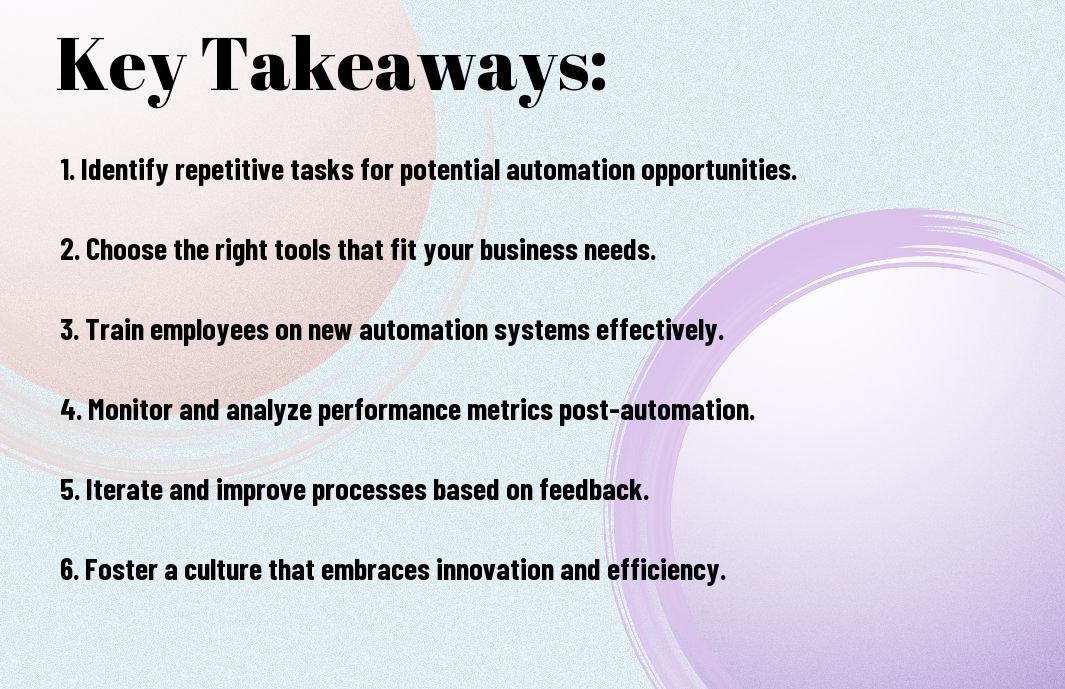With the rapid evolution of technology, embracing automation in your business becomes necessary for sustained growth. Implementing streamlined processes can significantly enhance efficiency and cut operational costs. In this post, you will discover necessary steps to empower automation tailored for your business needs. Explore insights from 18 Ways to Automate Your Business for Growth to elevate your operations and harness the full potential of automation.
Key Takeaways:
- Identify repetitive tasks within your organization that can benefit from automation to improve efficiency.
- Invest in the right tools and technologies that align with your business objectives and support workflow automation.
- Encourage a culture of innovation where employees are trained and motivated to embrace automation and technology.
- Continuously monitor and analyze the performance of automated processes to optimize and enhance outcomes.
- Engage with stakeholders to gather feedback and make necessary adjustments for successful integration of automation solutions.

Understanding Automation in Business
For many businesses, automation is a game changer that enhances efficiency, reduces human error, and allows your team to focus on strategic tasks. Understanding how automation integrates into various business processes can help you streamline operations and boost productivity. This awareness is crucial as you initiate on your journey towards leveraging technology for growth.
Definition of Automation
The term automation refers to the use of technology to perform tasks with minimal human intervention. It involves a range of processes, including software applications and tools designed to automate repetitive functions, thereby creating a more efficient workflow for you and your business.
Benefits of Automating Business Processes
Business automation provides a multitude of advantages that can significantly impact your operational efficiency. By minimizing manual work, you save time and resources, allowing your team to concentrate on tasks that drive growth. Automation also enhances accuracy, as it reduces the risk of human error, leading to improved quality and consistency in your services or products.
For instance, automating routine tasks like invoicing, data entry, or customer follow-ups can free up valuable hours in your team’s schedule. This not only empowers employees to engage in more critical, value-added activities but also streamlines operational workflows, leading to faster project completion and improved customer satisfaction. As your business grows, employing automation effectively can become a significant competitive advantage.

Identifying Areas for Automation
Even in today’s fast-paced business environment, many organizations overlook the potential for automation in their operations. To drive growth and enhance efficiency, you must identify repetitive and time-consuming tasks that can be automated. By recognizing these opportunities, you can streamline processes, reduce human error, and allow your team to focus on high-impact activities that contribute to your overall objectives.
Analyzing Current Business Processes
Beside examining your operational workflows, it’s important to document and assess your current business processes. This analysis will help you pinpoint bottlenecks, redundancies, and areas where automation can be introduced. By gaining a solid understanding of how work flows through your organization, you can make informed decisions about what tasks to prioritize for automation.
Prioritizing Tasks for Automation
Across your identified tasks, it’s vital to prioritize which ones to automate first. Focus on tasks that are repetitive, time-consuming, and prone to human error. Streamlining these tasks can lead to significant time and cost savings, shaping a more efficient operation while aligning with your strategic objectives.
And by prioritizing automation efforts, you can tackle the most impactful tasks first, laying the groundwork for broader implementation in the future. Assess the potential return on investment for each task and consider how automation can enhance your team’s productivity. This thoughtful approach will ensure that your automation initiatives not only address immediate needs but also support long-term growth in your business.
Selecting the Right Tools and Technologies
Many businesses face challenges in identifying the most effective tools and technologies for automation. To successfully empower automation in your operations, it’s necessary to evaluate and choose the right solutions that align with your goals. You can explore How to automate your business for growth: Actionable tips to help guide your decision-making process.
Criteria for Tool Selection
After outlining your automation goals, it’s important to consider specific criteria when selecting tools. Evaluate factors such as integration capabilities, scalability, ease of use, and customer support. Additionally, consider the cost relative to the potential return on investment, ensuring you choose tools that will effectively enhance your business processes.
Popular Automation Tools in the Market
Below are some popular automation tools that can enhance your business efficiency. Solutions like Zapier streamline workflows by connecting different apps, while HubSpot offers comprehensive marketing automation features. Additionally, tools like Asana and Trello aid in project management, helping you track tasks and deadlines effectively.
For instance, an all-in-one platform like Microsoft Power Automate allows you to create automated workflows between applications to reduce repetitive tasks. Email marketing tools such as Mailchimp enable you to automate communication with your audience, while CRM systems like Salesforce improve customer relationship management. By leveraging these popular tools, you can optimize your operations and foster growth.
Implementing Automation Solutions
Despite the many advantages that automation can bring to your business, successfully implementing these solutions requires careful consideration and strategy. You will need to assess your current workflows, identify areas for improvement, and select the right tools that will align with your goals. Taking the time to plan and execute the implementation process effectively will ensure that you maximize the benefits of automation and streamline your operations for future growth.
Planning the Implementation Process
Process mapping is vital for understanding how your current business operations function. By analyzing your workflows, you can pinpoint inefficiencies and bottlenecks that automation could resolve. This helps you to make informed decisions on which processes to automate and allows you to prioritize your implementation efforts based on potential impact and return on investment.
Training Staff for Automated Systems
To ensure a smooth transition to automated processes, training your staff on new technologies is vital. They need to understand how to use automated systems effectively to reap the full benefits. Providing comprehensive training empowers your employees and fosters a culture of adaptability within your organization.
Solutions for training staff can include hands-on workshops, online courses, and user-friendly manuals tailored to your specific automated systems. Engaging your employees in the training process promotes confidence and reduces resistance to change. Regular refresher courses and updates will keep everyone informed about new features and enhancements, ultimately leading to better performance and job satisfaction as they become adept at managing automated workflows.

Measuring Success and ROI
After implementing automation in your business, it’s important to evaluate its success and ROI. Track your organization’s performance through metrics that reflect efficiency and cost savings. Utilize insights gained from your data to refine processes and optimize your strategy. For more on this topic, check out How to Automate Your Business Processes for Exponential ….
Key Performance Indicators for Automation
Performance metrics play a significant role in assessing your automation initiatives. Focus on key performance indicators (KPIs) such as time savings, productivity rates, and customer satisfaction scores. By establishing clear KPIs, you can quantify the impact of automation on your business, enabling you to make informed decisions moving forward.
Adjusting Strategies for Continuous Improvement
Automation gives you the tools needed for ongoing enhancements in your processes. You might find that some areas require more attention or adjustments based on the data you gather. By regularly analyzing performance and gathering feedback, you can adapt your automation strategies to meet shifting business needs.
Also, fostering a culture that values continuous improvement is pivotal in maximizing the benefits of automation. Engaging your team in the evaluation process allows for diverse perspectives and innovative ideas. Set aside time for regular reviews to discuss performance data and brainstorm adjustments that can lead to higher efficiencies and overall success.
Overcoming Challenges in Automation
Your journey towards automation can be riddled with obstacles. From resistance to change among employees to the technical complexities of integrating new systems, it’s vital to anticipate these challenges. By recognizing potential pitfalls early, you can develop strategies that not only address these issues but also pave the way for smooth implementation and productivity gains.
Common Obstacles and Solutions
Challenges in automation often arise from a lack of understanding or concerns about job security among your team members. To overcome this, clear communication about the benefits and training programs can alleviate fears and promote a supportive environment. Additionally, investing in robust technology solutions can streamline processes and reduce frustration.
Building a Culture of Adaptability
Obstacles to adopting automation can be mitigated by fostering a culture of adaptability within your organization. When you encourage flexibility and a growth mindset among your workforce, they become more receptive to changes that automation brings.
The transition to an automated environment thrives on a workforce that is open to learning and innovation. You can achieve this by providing continuous training and support that empowers your employees to embrace new technologies and workflows. Regular feedback loops and celebrating successes can further enhance this culture, making your team more resilient and enthusiastic about future changes.
Final Words
From above, it’s clear that empowering automation in your business is a significant step toward achieving sustainable growth. By strategically integrating automation tools and processes, you can enhance efficiency, reduce costs, and focus on innovation. Start by assessing your current workflows, setting defined goals, and selecting the right technologies that align with your objectives. As you adopt these crucial steps, you’ll not only streamline operations but also position your business to adapt and thrive in an ever-changing marketplace.
FAQ
Q: What is Empower Automation in Business?
A: Empower Automation in Business refers to the integration of technology and software solutions to streamline processes, enhance productivity, and improve efficiency within an organization. This involves implementing tools that can automate repetitive tasks, allowing employees to focus on more strategic initiatives.
Q: What are the benefits of automating business processes?
A: The benefits of automating business processes include improved accuracy, reduced operational costs, faster turnaround times, enhanced data analysis, and better customer service. Automation allows businesses to minimize errors and optimize workflows, leading to increased overall efficiency.
Q: What steps should a business take to start automating processes?
A: To start automating processes, a business should first identify repetitive tasks, assess the current workflow, choose the right automation tools, train the staff on using these tools, and continuously monitor the automation’s effectiveness. Engaging employees throughout the process is also important to ensure buy-in and successful implementation.
Q: How can a business determine which processes to automate?
A: A business can determine which processes to automate by evaluating tasks that are time-consuming, prone to error, or high-volume. Prioritizing tasks that have a clear set of rules and those that can benefit from faster processing can help in making informed choices on what to automate.
Q: Are there any risks associated with business automation?
A: While automation offers numerous advantages, risks can include over-reliance on technology, potential job displacement, and security concerns regarding data handling. Businesses must have a solid strategy to mitigate these risks, such as ensuring cybersecurity measures and providing retraining programs for employees impacted by automation.
Q: How does employee training factor into successful automation?
A: Employee training is key to ensuring successful automation. Proper training empowers employees to effectively utilize automation tools, understand the changes in their workflows, and adapt to a more technology-driven environment. Involving employees in the transition process encourages a positive attitude towards automation.
Q: How can automation contribute to business growth?
A: Automation contributes to business growth by increasing operational efficiency, allowing for greater scalability, enhancing customer experience, and providing data insights for informed decision-making. By reducing manual effort, businesses can focus resources on strategic initiatives that drive innovation and expansion.

